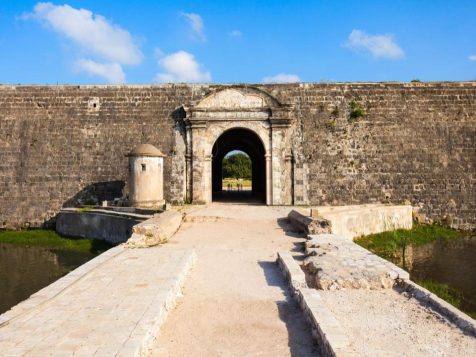Part of our colonial past, specifically during the time of the Portuguese, the Jaffna Fort was built in the year 1618 during their rule of the northern part of the island. In fact, Jaffna was ruled by the Arya Chakravarti dynasty, noble warriors and governors from Southern India, and Rameshwaram who took over the Northern Province during the 13th Century AD. The Arya Chakravarti line was one of Brahmans, supposedly the highest and noblest of the Hindu castes but in reality, their kingdom was very small, limited to an area centered on the city of Nallur. During much of their short history, the northern medieval kingdom was in actuality at loggerheads with the southern dominions of Kotte and Gampola. King Parakramabahu VI of Kotte finally subdued them but they bounced back just after his and his adopted son’s passing, albeit nothing was really done through the fall of Kotte and the rise of Kandy as a prime Sinhalese dominion. For a long time, they were silent, but their homeland provided enough space for a number of ships to be repaired at the natural inlets and little isles surrounding the peninsula. Plus we know that the Jaffna kings maintained close contact with their dynastic cousins, the Vijayanagar kings of Tamil Nadu, the last great Hindu empire in India.
The Portuguese however, tipped the balance by their invasion of the country. During the reign of the last Arya Chakravarti rulers, the common people and the foreigners themselves faced great hardships. There were often mass genocides of the European settlers and destruction of their towns and places of worship; no doubt it prompted the building of one of the largest military fortresses in the country. Situated across from the Jaffna Lagoon, and in the vicinity of the famous Jaffna Library-which saw a terrible incident in the form of an inquisition-style burning during the age of civil conflicts-and the Dore Appu Stadium. The fort itself, while constructed by the Portuguese, was actually more its own entity during the Dutch era.
During this time, from about 1658, the Dutch overran the older Portuguese military bases as per the treaty with the King of Kandy, the famous Rajasinghe II. However, they also developed them and turned these bases into their own works of art.
Finally, the British took over it in 1795, keeping it as a main military base until 1948 when it was handed over to the Sri Lankan Army itself. The Jaffna Fort for one is made of the petrified black corals that are common in the northern reefs. Standing on one of the high parapets or ramparts of the fort gives one a sense of the intricacy of the architecture of the whole structure, with the moats and the view overlooking the great lagoon itself.
While the fort as a whole has been under fire during the thirty years of conflict, it has also been manned by the Sri Lankan Army for a short period during the war. In fact, it was in the hands of the enemy from 1986 to 1995, after which the country took it back. This was after Operation Riviresa, among the most decisive and well-known sieges in Sri Lankan modern military history. The Battle for Jaffna included a fifty-day siege of the fort, after which the Army took it back from the LTTE. One of the best-preserved parts of the fortress is the Queen’s House. This area is incredible in its architectural and artistic look, with the combination of the beautifully Dutch style with the underlying Portuguese work clearly visible as well. That is, the verandah, being part of the former architecture, might have existed at the very entrance of the Queen’s House along with a pair of ponds. Yet this particular building is still in a heavy state of restoration as well.
Written by Vasika Udurawane for Travel Lanka Compass



0 Comment